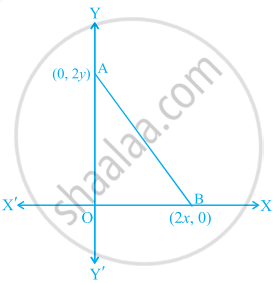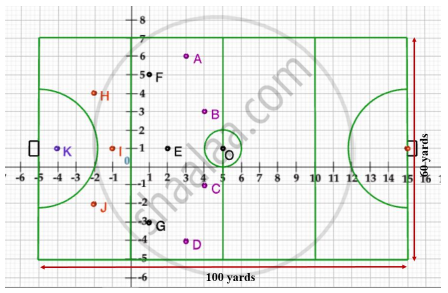Advertisements
Advertisements
Question
Show that the points P (0, 5), Q (5, 10) and R (6, 3) are the vertices of an isosceles triangle.
Solution
PQ = `sqrt((5 - 0)^2 + (10 - 5)^2`
= `sqrt(25+25)`
= `sqrt(50)`
= 5`sqrt(2)`
QR = `sqrt((6 - 5)^2 + (3 - 10)^2`
= `sqrt(1+49)`
= `sqrt(50)`
= 5`sqrt(2)`
RP = `sqrt((0 - 6)^2 + (5 - 3)^2`
= `sqrt(36+4)`
= `sqrt(40)`
= 2`sqrt(10)`
Since, PQ = QR, ΔPQR is an isosceles triangle.
APPEARS IN
RELATED QUESTIONS
If the point A(0, 2) is equidistant from the points B(3, p) and C(p, 5), find p. Also, find the length of AB.
Show that the points (1, – 1), (5, 2) and (9, 5) are collinear.
If P and Q are two points whose coordinates are (at2 ,2at) and (a/t2 , 2a/t) respectively and S is the point (a, 0). Show that `\frac{1}{SP}+\frac{1}{SQ}` is independent of t.
If the opposite vertices of a square are (1, – 1) and (3, 4), find the coordinates of the remaining angular points.
If P (2, – 1), Q(3, 4), R(–2, 3) and S(–3, –2) be four points in a plane, show that PQRS is a rhombus but not a square. Find the area of the rhombus
Find the coordinates of the centre of the circle passing through the points (0, 0), (–2, 1) and (–3, 2). Also, find its radius.
Show that the points A (1, −2), B (3, 6), C (5, 10) and D (3, 2) are the vertices of a parallelogram.
Find all possible values of x for which the distance between the points
A(x,-1) and B(5,3) is 5 units.
For what values of k are the points (8, 1), (3, –2k) and (k, –5) collinear ?
Find the relation between a and b if the point P(a ,b) is equidistant from A (6,-1) and B (5 , 8).
ABCD is a square . If the coordinates of A and C are (5 , 4) and (-1 , 6) ; find the coordinates of B and D.
A(2, 5), B(-2, 4) and C(-2, 6) are the vertices of a triangle ABC. Prove that ABC is an isosceles triangle.
Find distance CD where C(– 3a, a), D(a, – 2a)
AOBC is a rectangle whose three vertices are A(0, 3), O(0, 0) and B(5, 0). The length of its diagonal is ______.
The coordinates of the point which is equidistant from the three vertices of the ΔAOB as shown in the figure is ______.

Case Study -2
A hockey field is the playing surface for the game of hockey. Historically, the game was played on natural turf (grass) but nowadays it is predominantly played on an artificial turf.
It is rectangular in shape - 100 yards by 60 yards. Goals consist of two upright posts placed equidistant from the centre of the backline, joined at the top by a horizontal crossbar. The inner edges of the posts must be 3.66 metres (4 yards) apart, and the lower edge of the crossbar must be 2.14 metres (7 feet) above the ground.
Each team plays with 11 players on the field during the game including the goalie. Positions you might play include -
- Forward: As shown by players A, B, C and D.
- Midfielders: As shown by players E, F and G.
- Fullbacks: As shown by players H, I and J.
- Goalie: As shown by player K.
Using the picture of a hockey field below, answer the questions that follow:

The coordinates of the centroid of ΔEHJ are ______.
The point A(2, 7) lies on the perpendicular bisector of line segment joining the points P(6, 5) and Q(0, – 4).
A point (x, y) is at a distance of 5 units from the origin. How many such points lie in the third quadrant?
